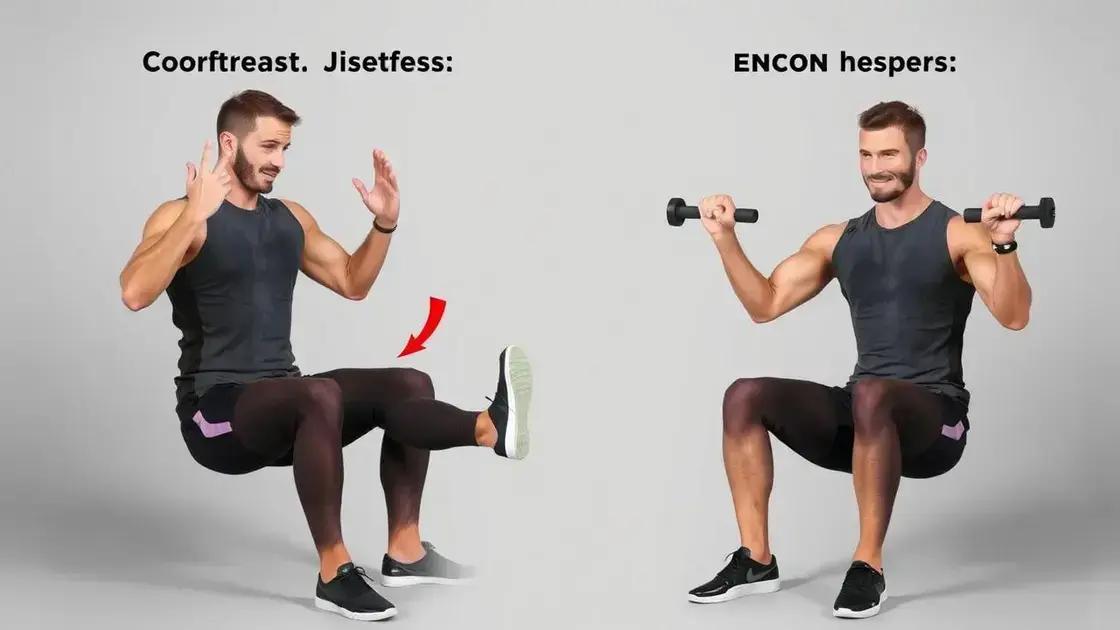Slow isometric holds are exercises where you maintain a static position for a prolonged time, enhancing muscle engagement and strength. Benefits include increased muscle strength, endurance, and reduced injury risks. To incorporate isometric holds, focus on proper form, integrate them with your routine, and avoid common mistakes like poor posture or holding too long. Ideal for beginners, these exercises can complement traditional strength training for overall fitness improvement.
Incorporating slow isometric holds into your workout routine is a powerful way to enhance muscle engagement and boost strength. These unique exercises focus on holding a muscle in a static position, which can lead to significant improvements in endurance and muscle activation. In this guide, we will explore what isometric holds are, their benefits, and how to effectively incorporate them into your training plan. With insights on avoiding common mistakes, you’ll be well-equipped to maximize your strength training.
Understanding Isometric Holds

Isometric holds are a type of exercise where you hold a position for an extended period, often without any movement. This technique can significantly enhance muscle engagement and strength. Unlike dynamic exercises, isometric holds do not require lifting weights or changing positions. Instead, they focus on maintaining tension in the muscles, making them a valuable addition to any training regimen.
The Science Behind Isometric Holds
When you perform an isometric hold, your muscles contract without changing their length. This creates tension, which sends signals to the brain, enhancing muscle fibers’ activation. Studies show that isometric exercises can lead to increases in muscle strength and size, making them ideal for everyone from beginners to advanced athletes.
Types of Isometric Holds
There are various types of isometric holds you can incorporate into your workouts, including:
- Static holds: These involve holding a position, like a plank or wall sit, where your muscles remain engaged.
- Flexed holds: Involves holding a weight at a certain point in a lift—think of holding a dumbbell halfway through a bicep curl.
- Isometric contractions: These can be done against a fixed object or surface, like pressing your palms together.
Why Isometric Holds Matter
Incorporating these holds into your routine can lead to improved endurance and better performance in other exercises. As your muscles learn to sustain tension, they will efficiently engage during dynamic movements as well. Plus, isometric holds are a great option for those recovering from injuries, as they can improve strength with less risk of harm.
Understanding isometric holds is crucial for optimizing your training. The right techniques can help you build strength, enhance muscle engagement, and boost your workout results.
Benefits of Slow Isometric Training

Slow isometric training offers a range of impressive benefits that can enhance your workout routine and overall fitness. This type of exercise emphasizes holding positions for an extended time, leading to muscle engagement and strength development.
1. Increased Muscle Strength
Performing slow isometric holds can significantly build muscle strength. When muscles maintain tension for longer periods, they adapt by becoming stronger. This adaptation occurs because muscle fibers are engaged more deeply than in typical dynamic movements.
2. Improved Muscle Endurance
Slow isometric training helps increase muscle endurance. By holding a position, your muscles learn to resist fatigue, which improves performance in various activities. Over time, you’ll notice that you can perform exercises for longer without tiring.
3. Greater Muscle Activation
When holding a position, more muscle fibers are activated compared to quicker movements. This increased activation helps enhance muscle growth and effectiveness during workouts. Greater muscle engagement leads to better results, making it a highly effective training method.
4. Reduced Risk of Injury
Isometric exercises are generally safer than traditional strength training methods. They put less stress on joints, making them suitable for people recovering from injuries or those new to fitness. Slow isometric holds allow you to focus on form without the risk of weights dropping or sudden movements.
5. Versatile and Convenient
Slow isometric training can be done nearly anywhere, requiring little to no equipment. You can perform exercises like wall sits or planks at home, in the gym, or even at the office. This versatility allows you to include isometric holds in various routines effortlessly.
Overall, the benefits of slow isometric training make it a valuable asset for anyone looking to enhance their strength, endurance, and overall fitness. Incorporating these techniques into your workout routines can lead to impressive results over time.
How to Incorporate Isometric Holds into Your Routine

Incorporating isometric holds into your routine can be easy and effective. Here are some simple steps to follow:
1. Start with Basic Exercises
Begin with simple isometric exercises such as wall sits, planks, or a static lunge. These movements help your body understand the concept of holding tension without movement.
2. Choose the Right Timing
Isometric holds can be added to your workouts at various times. You can include them during warm-ups, as part of the main workout, or even in recovery sessions. A great approach is to incorporate 30-second holds into different exercises, gradually increasing the time as you get stronger.
3. Mix with Dynamic Movements
Combining isometric holds with dynamic exercises can enhance your overall strength training. For example, perform a set of push-ups, then hold the bottom position for a few seconds before pushing up. This technique will engage your muscles differently, leading to better results.
4. Focus on Form
Proper form is crucial when performing isometric holds. Maintain good posture and engage your core to ensure your workout is effective. If you are unsure about your form, consider using a mirror or filming yourself to make adjustments as needed.
5. Create a Consistent Schedule
Try to include isometric holds in your routine at least 2-3 times a week. Establishing consistency will help you build strength over time. You can start with shorter holds and gradually increase the duration as you progress.
By following these steps, you can easily incorporate isometric holds into your fitness routine and enhance your muscle engagement and strength.
Common Mistakes in Isometric Training

Even though isometric training has many benefits, there are common mistakes that people make. Avoiding these errors can help you get the most out of your workouts.
1. Poor Form
One of the biggest mistakes is not maintaining proper form. When doing isometric holds, it is important to keep your body aligned. Poor posture can lead to injuries and reduce the effectiveness of the exercise. Always engage your core and align your joints correctly.
2. Holding Too Long
Another mistake is holding positions for too long. While isometric exercises are about holding, it is important to listen to your body. Holding a position for longer than necessary can lead to muscle fatigue and strain. Start with shorter holds and gradually increase the duration.
3. Lack of Variety
Doing the same isometric holds repeatedly can cause your muscles to adapt, leading to less effective workouts. To avoid this, mix different isometric exercises into your routine. This variety will challenge your muscles and promote better gains.
4. Ignoring Breathing
Many people forget to breathe properly while holding positions. Holding your breath can lead to increased tension and less oxygen flow to the muscles. Focus on steady, even breathing to help maintain muscle contraction and optimize performance.
5. Skipping Warm-Up and Cool-Down
Jumping into isometric training without warming up is a mistake. It can lead to injury and reduce effectiveness. Always include a warming routine to prepare your muscles. Similarly, a cool-down session after your workout can help prevent soreness and promote recovery.
By being aware of these common mistakes, you can enhance your isometric training and achieve better results.
In Conclusion: Mastering Slow Isometric Holds for Muscle Engagement
Incorporating slow isometric holds into your workout routine can be highly beneficial for building strength and enhancing muscle engagement. Understanding the principles of isometric training, recognizing the common mistakes, and knowing how to effectively integrate these holds into your exercises are key components to achieving impressive results.
By avoiding poor form, varying your exercises, and paying attention to your breathing, you can maximize the effectiveness of isometric holds. Remember the importance of warming up and cooling down to protect your muscles and promote recovery.
Ultimately, with consistent practice and attention to detail, you can leverage the power of slow isometric holds to transform your strength training and reach your fitness goals.
FAQ – Frequently Asked Questions about Slow Isometric Holds
What are slow isometric holds?
Slow isometric holds are exercises where you maintain a position for a prolonged time without moving, enhancing muscle engagement and strength.
What are the benefits of isometric training?
Isometric training improves muscle strength, increases endurance, and reduces the risk of injury while being versatile and easy to incorporate.
How can I incorporate isometric holds into my routine?
You can incorporate isometric holds by starting with basic exercises, mixing them with dynamic movements, and focusing on proper form during your workouts.
What are common mistakes in isometric training?
Common mistakes include poor form, holding positions for too long, neglecting breathing, and skipping warm-up and cool-down routines.
How long should I hold an isometric position?
Start with holding an isometric position for about 10-30 seconds, gradually increasing the duration as you build strength and endurance.
Are isometric exercises suitable for beginners?
Yes, isometric exercises are great for beginners as they can be performed without weights and focus on maintaining muscle engagement safely.












